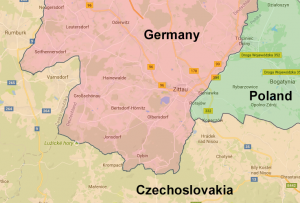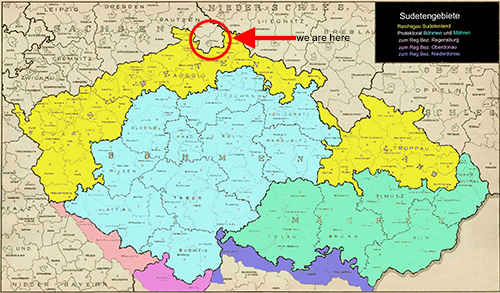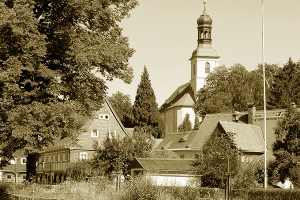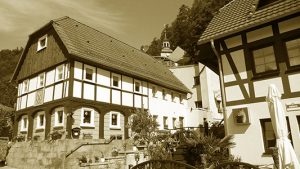The village of Bad Bernsdorf lies at the foot of the highest of the Zittau Mountains in South Saxony, where the borders of Germany, Czechoslovakia and Poland meet.
 Although there is no station in Bad Bernsdorf, it is not uncommon for trains to be delayed by snowfall in the nearby mountains. When this happens, it is usual for stranded travellers (well, the First Class travellers) to be brought to the famous Hotel de Saxe, the best known hotel in the region.
Although there is no station in Bad Bernsdorf, it is not uncommon for trains to be delayed by snowfall in the nearby mountains. When this happens, it is usual for stranded travellers (well, the First Class travellers) to be brought to the famous Hotel de Saxe, the best known hotel in the region.
Indeed, the Hotel de Saxe does not have to wait for stranded rail passengers; it is an excellent location for those wishing to ski in the nearby mountains in winter – or undertaking walks or bathing in the nearby rivers in summer. In addition, the Hotel has an excellent chef and a small, discreet casino where chemin de fer is played and the stakes are very high.
What happens to stranded Second and Third Class travellers? They need not concern us.
For information on the characters so far, look here.
~~~~~~~~~~~~~
The Political Situation
The Zittau Mountains are in South Saxony, located at a point where Germany, Czechoslovakia and Poland meet.
In 1937/8, this was a heavily disputed area. Across the border, in Czechoslovakia, was an area with a large German population, known as the Sudetenland.

The Sudentenland – our area highlighted
The Sudetenland, in the first half of the 20th Century, was the German name for the border regions of Northern and Western Czechoslovakia. These regions were mostly inhabited by ethnic Germans. It is shown as the light brown shaded areas in the map above. Before 1918, this area had little mention in history, as it was just another ethnic German part of the Austro-Hungarian Empire.
After World War I, the Austro-Hungarian Empire was broken up into separate nations. In September 1918, United States President Woodrow Wilson proposed ceding these ethnic German parts of Bohemia to Germany and Austria. The U.S. delegation later backed off this proposal, and in 1919, these ethnic German areas were incorporated into the new nation of Czechoslovakia.
As a result of this decision, more than 23% of the total post-war population of Czechoslovakia was made up of Germans. Tensions between the Czechs and the Germans, who constituted the majority in Sudetenland, lingered through the 1920’s and intensified in the 1930’s.
During the Great Depression these mainly mountainous regions populated by ethnic Germans were hurt by the economic crisis more than the interior parts of Czechoslovakia were. High unemployment made the people more open to populist and extremist movements, and the parties of the German nationalists gained immense popularity among the ethnic Germans within Czechoslovakia.
By late 1937, even before the Anschluss (when Austria was incorporated within the Nazi Reich), plans were already being made for expansion into Czechoslovakia under the guise of coming to the “rescue” of the German population of the Sudentenland.
See: https://en.wikipedia.org/wiki/Sudetenland and
https://en.wikipedia.org/wiki/Joachim_von_Ribbentrop#Munich_Agreement_and_Czechoslovakia.27s_destruction
~~~~~~~~~~~~~
The Geographical Location

Mountain Village
The Zittau Mountains are not so high or as well known as the Alps, but have several ski runs, and also opportunities for cross-country skiing. However, it would be easy to cross the border by mistake!
There are many rivers in the area, and several lakes. However, although skating might be a possibility, swimming would definitely not be at this time of year.
In 1937, this part of South Saxony had an important textile industry, one of the oldest in Europe, specialising in damask, linen, and towelling. Each small village in the area would have its own mill, with a chimney taller than the village church.
There are many pretty villages throughout this area. Bad Bernsdorf is based upon an amalgamation of the villages of Großschönau and Waltersdorf.
The local version of the Women’s Institute makes amazingly good cakes. But that’s another story.
The Zittau Mountains: https://en.wikipedia.org/wiki/Zittau_Mountains
Großschönau and Waltersdorf: http://www.grossschoenau.de/cms/en/7/Our-municipality
~~~~~~~~~~~~~
Architecture

Umgebindehaus
There is also a specialised style of architecture, unique to this area, called the Umgebindehäus or Upper Lusatian house, which combines log house, timber-framing and building stone methods of construction in a highly individual style.
See: https://en.wikipedia.org/wiki/Upper_Lusatian_house
The Hotel de Saxe (inspired by the Quirle Hausl in Waltersdorf) is partially an Umgebindehäus (there is an annexe in a different regional style).
Here are some very rough floor plans for the Hotel de Saxe which should help to find various locations mentioned in the story.
Some videos to watch:
The village: https://www.youtube.com/watch?v=lp6bTn9cCLk
The hotel: https://www.youtube.com/watch?v=D-HKPaZabPo
Umgebindehäuser in der Upper Lusatia: https://www.youtube.com/watch?v=hzUj9wTFrIw

Recent Comments